This is for Felicity and all the rest of you who crave knowing more about how inspiration and surroundings influence work. Bless your curiosity - it got me thinking about just what it is I see and how that makes its way into some of my quilts. Bear in mind, though, that the following observations are generalizations. As I sorted through my thoughts, I realized that for each area I identified, I could immediately think of exceptions. But I think this is a good start to understanding how I see.
As I've mentioned in "Where Inspiration" I glean many (but not all) ideas from nature. So I thought I'd use, among others, some of the pictures I took last weekend to illustrate what I mean. Click on any of them for a larger view.
I think it is fair to say I see in three basic ways and often in this order: 1) line; 2) texture; and 3) color. Does it surprise you that color would be last? It surprised me a bit, but after careful consideration, I decided that at least these days, that is true. Now let me explain what I mean by each category.
Line
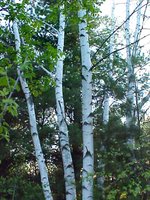 When I refer to line, I mean not just a straight line, but curved and undulating lines as well. I also cannot separate line from shape, which afterl all, is just a line whose beginning and end meet. Sometimes contrast enters in, because without it, a line or shape would have no definition. Traditional quilt designs are all about line and shape, and those endless patterns made up of lines and contrast were what originally fascinated me. I'm thinking the real connection between what I observed in nature and quilt designs started when I moved to this area about 5 years ago, and started walking regularly through a heavily wooded area nearby. It was mostly pines with some oak trees, and against this dark backdrop, the occasional stark white of birch tree trunks that naturally caught the eye. Light and dark wasn't the only contrast my eye picked up on. I found myself interested in the gentle curves of the birch trunks, interrupted by very few branches, so different from the straight and heavily branched trunks of the pines. About this same time I was losing my fear of curved piecing and applique thanks to some techniques picked up in workshops. This opened the door to so many more design possibilities as I gained confidence in being able to execute them. That undoubtedly led to my eye being more attracted to curves in nature and a near obsession with subtle curves and interesting shapes.
When I refer to line, I mean not just a straight line, but curved and undulating lines as well. I also cannot separate line from shape, which afterl all, is just a line whose beginning and end meet. Sometimes contrast enters in, because without it, a line or shape would have no definition. Traditional quilt designs are all about line and shape, and those endless patterns made up of lines and contrast were what originally fascinated me. I'm thinking the real connection between what I observed in nature and quilt designs started when I moved to this area about 5 years ago, and started walking regularly through a heavily wooded area nearby. It was mostly pines with some oak trees, and against this dark backdrop, the occasional stark white of birch tree trunks that naturally caught the eye. Light and dark wasn't the only contrast my eye picked up on. I found myself interested in the gentle curves of the birch trunks, interrupted by very few branches, so different from the straight and heavily branched trunks of the pines. About this same time I was losing my fear of curved piecing and applique thanks to some techniques picked up in workshops. This opened the door to so many more design possibilities as I gained confidence in being able to execute them. That undoubtedly led to my eye being more attracted to curves in nature and a near obsession with subtle curves and interesting shapes.
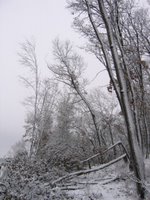 Here is a shot from last weekend. There's a lot going on in this picture, but my eye was focused on the curve of the tree in the center. Secondary to that, I noticed the interesting contrast set up by the way the snow covered the right side of the trees nearer and to the right, echoing the line of the trunk Lastly, I noticed the angles created by the trees that had been snapped off near their bases in a recent storm. So when I look at a scene, I usually am not looking at it as a whole composition, but at individual components that may or may not be used together.
Here is a shot from last weekend. There's a lot going on in this picture, but my eye was focused on the curve of the tree in the center. Secondary to that, I noticed the interesting contrast set up by the way the snow covered the right side of the trees nearer and to the right, echoing the line of the trunk Lastly, I noticed the angles created by the trees that had been snapped off near their bases in a recent storm. So when I look at a scene, I usually am not looking at it as a whole composition, but at individual components that may or may not be used together.
To the left of this shot is a grassy area. The recent heavy snow had bent the clumps of grass into interesting shapes. Perhaps I found them interesting because I knew that normally they would be stalks rising perfectly straight in the air. I think I was also attracted by the fact that it was not just one clump shaped into a curve, but repeating similar shapes creating a certain rhythm to the scene.
And lest these pictures make you think I live on the edge of the wilderness, they are taken in a section not much bigger than a city block hemmed in by houses and roads. Note in the picture below that it overlooks a 4-lane highway! Texture
Texture
After line, I often see texture. Texture is created by intersecting lines and curves, or a denseness of line and curve, parallel or at angles. Here is grass from a different spot, this time maintaining more of its individuality, so rather than shape, I am seeing how the blades overlap to create an interesting texture.
 Here are two other examples of texture. They are formed by the many small dark branches of the trees as outlined by the snow. In the one to the right, I see the interesting lines, then the background texture of the branches. In the one below, my eye is seeing past the larger lines created by the trunks and focusing on that fine texture.
Here are two other examples of texture. They are formed by the many small dark branches of the trees as outlined by the snow. In the one to the right, I see the interesting lines, then the background texture of the branches. In the one below, my eye is seeing past the larger lines created by the trunks and focusing on that fine texture.

Color
Usually it is fabric that gives me my color cues. I don't think I consciously looked to nature until I was encouraged to do so by Jinny Beyer and Joen Wolfrom. For a gal who grew up in the woods of Idaho, I was woefully unaware of the variety of greens nature successfully combines, greens that I was taught clashed. No way would I combine them in my quilt! In fact, after reading about these greens in Joen's book, I marched right out to my favorite stand of trees to prove her wrong. To my amazement, I indeed saw as many as 6 different greens, all working beautifully together towards a richer more interesting scene.
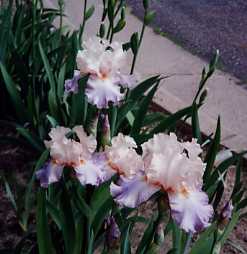 Once I started appliqueing, I began looking more closely at flowers, leaves and landscapes in general for color cues. At one point I was collecting iris patterns and was thrilled to discover an extensive iris garden along my morning route. I only meant to get some ideas of different colors I could use (did they come in more than purple?), and just what color were those fuzzy parts near the center? On close examination, I discovered an amazing array of hues, tints, and shades used in combinations I had not considered.
Once I started appliqueing, I began looking more closely at flowers, leaves and landscapes in general for color cues. At one point I was collecting iris patterns and was thrilled to discover an extensive iris garden along my morning route. I only meant to get some ideas of different colors I could use (did they come in more than purple?), and just what color were those fuzzy parts near the center? On close examination, I discovered an amazing array of hues, tints, and shades used in combinations I had not considered.
Other than these examples, I usually do not look specifically for color. It tends to find me, after my eye has assessed line and texture to move on to subtle shadings, stark contrasts, unexpected combinations. More likely, it takes me by surprise. I notice certain colors at certain times of the year, like the particular green of new leaves in spring or the turquoise tint of a winter sky.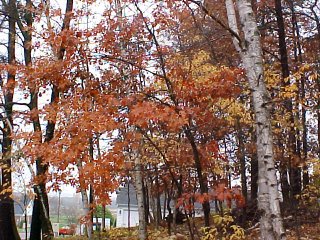
Swaths of color catch my attention too as in a hillside turned russet and gold in autumn. In the picture to the left, I wasn't seeing individual leaves but the layering and placement of the yellow and orange accented by streaks of black and white. I was envisioning a pieced design having nothing to do with leaves and trees but using those colors in those placements and proportions.
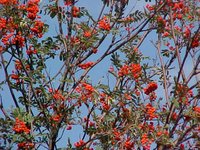 Occasionally I note how two colors play off each other like the red of the mountain ash berries against this blue sky. Those orange-red berries popped! I have to admit, when I think red and blue, I'm more apt to choose a burgundy or brick and a stronger blue, probably navy. This red was a revelation at the time.
Occasionally I note how two colors play off each other like the red of the mountain ash berries against this blue sky. Those orange-red berries popped! I have to admit, when I think red and blue, I'm more apt to choose a burgundy or brick and a stronger blue, probably navy. This red was a revelation at the time.
And while we're looking at the sky, let's not forget sunsets. I can't begin to describe all I've seen in them. Talk about a range of hue, tint, shade and tone, all shifting and changing until all dissolves into grey and black. Parts shimmer, others are simply pale. Some colors are vibrant and saturated. They all work together, in spite of my tendency to believe they can't. They always make me puzzle over how I can recreate them in fabric.
In a separate post, I'll talk specifically about and show examples of how all this plays into my quilting.
As I've mentioned in "Where Inspiration" I glean many (but not all) ideas from nature. So I thought I'd use, among others, some of the pictures I took last weekend to illustrate what I mean. Click on any of them for a larger view.
I think it is fair to say I see in three basic ways and often in this order: 1) line; 2) texture; and 3) color. Does it surprise you that color would be last? It surprised me a bit, but after careful consideration, I decided that at least these days, that is true. Now let me explain what I mean by each category.
Line
 When I refer to line, I mean not just a straight line, but curved and undulating lines as well. I also cannot separate line from shape, which afterl all, is just a line whose beginning and end meet. Sometimes contrast enters in, because without it, a line or shape would have no definition. Traditional quilt designs are all about line and shape, and those endless patterns made up of lines and contrast were what originally fascinated me. I'm thinking the real connection between what I observed in nature and quilt designs started when I moved to this area about 5 years ago, and started walking regularly through a heavily wooded area nearby. It was mostly pines with some oak trees, and against this dark backdrop, the occasional stark white of birch tree trunks that naturally caught the eye. Light and dark wasn't the only contrast my eye picked up on. I found myself interested in the gentle curves of the birch trunks, interrupted by very few branches, so different from the straight and heavily branched trunks of the pines. About this same time I was losing my fear of curved piecing and applique thanks to some techniques picked up in workshops. This opened the door to so many more design possibilities as I gained confidence in being able to execute them. That undoubtedly led to my eye being more attracted to curves in nature and a near obsession with subtle curves and interesting shapes.
When I refer to line, I mean not just a straight line, but curved and undulating lines as well. I also cannot separate line from shape, which afterl all, is just a line whose beginning and end meet. Sometimes contrast enters in, because without it, a line or shape would have no definition. Traditional quilt designs are all about line and shape, and those endless patterns made up of lines and contrast were what originally fascinated me. I'm thinking the real connection between what I observed in nature and quilt designs started when I moved to this area about 5 years ago, and started walking regularly through a heavily wooded area nearby. It was mostly pines with some oak trees, and against this dark backdrop, the occasional stark white of birch tree trunks that naturally caught the eye. Light and dark wasn't the only contrast my eye picked up on. I found myself interested in the gentle curves of the birch trunks, interrupted by very few branches, so different from the straight and heavily branched trunks of the pines. About this same time I was losing my fear of curved piecing and applique thanks to some techniques picked up in workshops. This opened the door to so many more design possibilities as I gained confidence in being able to execute them. That undoubtedly led to my eye being more attracted to curves in nature and a near obsession with subtle curves and interesting shapes. Here is a shot from last weekend. There's a lot going on in this picture, but my eye was focused on the curve of the tree in the center. Secondary to that, I noticed the interesting contrast set up by the way the snow covered the right side of the trees nearer and to the right, echoing the line of the trunk Lastly, I noticed the angles created by the trees that had been snapped off near their bases in a recent storm. So when I look at a scene, I usually am not looking at it as a whole composition, but at individual components that may or may not be used together.
Here is a shot from last weekend. There's a lot going on in this picture, but my eye was focused on the curve of the tree in the center. Secondary to that, I noticed the interesting contrast set up by the way the snow covered the right side of the trees nearer and to the right, echoing the line of the trunk Lastly, I noticed the angles created by the trees that had been snapped off near their bases in a recent storm. So when I look at a scene, I usually am not looking at it as a whole composition, but at individual components that may or may not be used together.To the left of this shot is a grassy area. The recent heavy snow had bent the clumps of grass into interesting shapes. Perhaps I found them interesting because I knew that normally they would be stalks rising perfectly straight in the air. I think I was also attracted by the fact that it was not just one clump shaped into a curve, but repeating similar shapes creating a certain rhythm to the scene.

And lest these pictures make you think I live on the edge of the wilderness, they are taken in a section not much bigger than a city block hemmed in by houses and roads. Note in the picture below that it overlooks a 4-lane highway!
 Texture
TextureAfter line, I often see texture. Texture is created by intersecting lines and curves, or a denseness of line and curve, parallel or at angles. Here is grass from a different spot, this time maintaining more of its individuality, so rather than shape, I am seeing how the blades overlap to create an interesting texture.

 Here are two other examples of texture. They are formed by the many small dark branches of the trees as outlined by the snow. In the one to the right, I see the interesting lines, then the background texture of the branches. In the one below, my eye is seeing past the larger lines created by the trunks and focusing on that fine texture.
Here are two other examples of texture. They are formed by the many small dark branches of the trees as outlined by the snow. In the one to the right, I see the interesting lines, then the background texture of the branches. In the one below, my eye is seeing past the larger lines created by the trunks and focusing on that fine texture.
Color
Usually it is fabric that gives me my color cues. I don't think I consciously looked to nature until I was encouraged to do so by Jinny Beyer and Joen Wolfrom. For a gal who grew up in the woods of Idaho, I was woefully unaware of the variety of greens nature successfully combines, greens that I was taught clashed. No way would I combine them in my quilt! In fact, after reading about these greens in Joen's book, I marched right out to my favorite stand of trees to prove her wrong. To my amazement, I indeed saw as many as 6 different greens, all working beautifully together towards a richer more interesting scene.
 Once I started appliqueing, I began looking more closely at flowers, leaves and landscapes in general for color cues. At one point I was collecting iris patterns and was thrilled to discover an extensive iris garden along my morning route. I only meant to get some ideas of different colors I could use (did they come in more than purple?), and just what color were those fuzzy parts near the center? On close examination, I discovered an amazing array of hues, tints, and shades used in combinations I had not considered.
Once I started appliqueing, I began looking more closely at flowers, leaves and landscapes in general for color cues. At one point I was collecting iris patterns and was thrilled to discover an extensive iris garden along my morning route. I only meant to get some ideas of different colors I could use (did they come in more than purple?), and just what color were those fuzzy parts near the center? On close examination, I discovered an amazing array of hues, tints, and shades used in combinations I had not considered.Other than these examples, I usually do not look specifically for color. It tends to find me, after my eye has assessed line and texture to move on to subtle shadings, stark contrasts, unexpected combinations. More likely, it takes me by surprise. I notice certain colors at certain times of the year, like the particular green of new leaves in spring or the turquoise tint of a winter sky.

Swaths of color catch my attention too as in a hillside turned russet and gold in autumn. In the picture to the left, I wasn't seeing individual leaves but the layering and placement of the yellow and orange accented by streaks of black and white. I was envisioning a pieced design having nothing to do with leaves and trees but using those colors in those placements and proportions.
 Occasionally I note how two colors play off each other like the red of the mountain ash berries against this blue sky. Those orange-red berries popped! I have to admit, when I think red and blue, I'm more apt to choose a burgundy or brick and a stronger blue, probably navy. This red was a revelation at the time.
Occasionally I note how two colors play off each other like the red of the mountain ash berries against this blue sky. Those orange-red berries popped! I have to admit, when I think red and blue, I'm more apt to choose a burgundy or brick and a stronger blue, probably navy. This red was a revelation at the time.And while we're looking at the sky, let's not forget sunsets. I can't begin to describe all I've seen in them. Talk about a range of hue, tint, shade and tone, all shifting and changing until all dissolves into grey and black. Parts shimmer, others are simply pale. Some colors are vibrant and saturated. They all work together, in spite of my tendency to believe they can't. They always make me puzzle over how I can recreate them in fabric.
In a separate post, I'll talk specifically about and show examples of how all this plays into my quilting.
3 comments:
Thank you Sheila, I have learned a lot from this post. (And thanks for the comments on Annabels blog - reading them made me feel so much better!) With quilts I haven't reached the stage where I'm interpreting my surroundings. I've been playing with colour and am only recently thinking of texture. I think this has a lot to do with the subject you and Annabel have touched on - other people's proclaimations of what we should so. Fear of getting it wrong instead of just doing it.
Fascinating post - I have much to think over now!
Stay tuned, Felicity. More to come! As I anaylze how all this relates to the quilts I've made, I'm realizing that some of these influences from my surroundings have subliminally worked their way into my quilts. Some day you may look back on your work and discover you have subconsciously interpreted bits and pieces of your surroundings as well.
As for the issue of texture, I see it but often don't know how to translate it. As I say - stay tuned. More on that soon.
Can't wait for the next episode! I am always amazed how much writing something down for another person sheds light on my own thoughts - it seems it's happening for you too!
Post a Comment